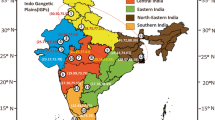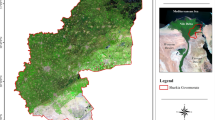Abstract
Long-term variations and trends of atmospheric aerosols in the East Asian region were analyzed by using aerosol optical depth (AOD or τ), and ångström exponent (AE or α) obtained from the Moderate Resolution Imaging Spectroradiometer (MODIS) from 2001 to 2010. The increased emission of anthropogenic fine aerosols in east China resulted in the high AOD in this region during summer. The steady increasing emission of anthropogenic fine aerosols caused an increasing trend of AOD in east China, and the large-scale transport of sandstorms and smoke plume caused by forest fires affected intense inter-annual variations of AOD in the East Asian region. While in the central part of South Korea, located in the lee side of the East Asian continent, AE tended to rise to a level higher than in east China, the ground-based mass concentrations continued to decline. A noticeable decrease of PM10 mass concentration in spring and winter in central Korea is most likely attributable to decreases in sandstorms in the source region of East Asia. However, the ratio of PM2.5 mass concentration to PM10 increases overall with a high level in summer. Aerosol types were classified into dust, smoke plume, and sulphate by using satellite data over Cheongwon in central Korea. The columnar AOD, with different aerosol types, was compared with the ground-based mass concentrations at Cheongwon, and the relatively high level of the correlations presented between PM2.5 and AOD produced in sulphate. Growth and increases of fine hygroscopic aerosols generated as gas-to-particle conversion particularly in summer contribute to increases of columnar AOD in the East Asian region.
Similar content being viewed by others
References
Acker, J. G., and G. Leptoukh, 2007: Online analysis enhances use of NASA earth science data. Eos, Trans. Amer. Geophys Union, 88, 14–17.
Akimoto, H., 2003: Global air quality and pollution. Science, 302, 1716–1719.
Chin, M., and Coauthors, 2002: Tropospheric aerosol optical thickness from the GOCART model and comparisons with satellite and sun photometer measurements. J. Atmos. Sci., 59, 461–483.
Chu, D. A., Y. J. Kaufman, G. Zibordi, J. D. Chern, J. Mao, C. Li, and B. N. Holben, 2003: Global monitoring of air pollution over the land from the Earth Observing System-Terra Moderate Resolution Imaging Spectro-radiometer (MODIS). J. Geophys. Res., 108, 4661.
Chung, Y. S., H. S. Kim, D. Jugder, L. Natsagdorj, and S. J. Chen, 2003: On sand and duststorms and associated significant dustfall observed in Chongju-Cheongwon, in Korea during 1997∼2000. Water, Air Soil Pollut.: Focus, 3–2, 5–19.
____, M. B. Yoon, and H. S. Kim, 2004: On climate variations and changes observed in south Korea. Climatic Change, 66, 151–161.
____, and H. S. Kim, 2008: Observations of massive air-pollution transport and associated air quality in the Yellow Sea region. Int. J. Air Quality, Atmos. Health, 1, 69–79.
Engel-Cox, J. A., C. H. Holloman, B. W. Coutant, and R. M. Hoff, 2004: Qualitative and quantitative evaluation of MODIS satellite sensor data for regional and urban scale air quality. Atmos. Environ., 38, 2495–2509.
Gerasopolous, E., M. O. Andreae, C. S. Zerefos, T. W. Andreae, D. Balis, P. Formenti, P. Merlet, V. Amiridis, and C. Papastefanou, 2003: Climatological aspects of aerosol optical properties in northern Greece. Atmos. Chem. Phys., 3, 2025–2041
Kang, G. U., N. S. Kim, and E. S. Shin, 2011: Seasonal characteristics of atmospheric PM10 and PM2.5 in Iksan, Korea. J. Environ. Health Sci., 37, 29–43.
Kaufman, Y. J., D. Tanré, and O. Boucher, 2002: A satellite view of aerosols in the climate system. Nature, 419, 215–223.
____, O. Ooucher, D. Tanre, M. Chin, A. Remer, and T. Takemura, 2005: Aerosol anthropogenic component estimated from satellite data. Geophys. Res. Lett., 32, L17804, doi: 10.1029/2005GL023125.
Kim, D. H., B. J. Sohn, T. Nakajima, T. Takamura, B. C. Choi, and S. C. Yoon, 2004: Aerosol optical properties over East Asia determined from ground-based sky radiation measurements. J. Geophys. Res., 109, D02209, DOI:10.1029/2003JD003387.
Kim, H. S., Y. S. Chung, and P. P. Tans, 2008: On the regional distributions of background carbon monoxide concentrations observed in East Asia during 1991~2008. Asia-Pacific J. Atmos. Sci., 46, 89–95.
____, _____, and S. G. Lee, 2012: Characteristics of aerosol types during large-scale transport of air pollution over the Yellow Sea region and at Cheongwon, Korea, in 2008. Environ. Monitor. Assess., 184, 1973–1984.
Kim, S. W., S. C. Yoon, J. Kim, and S. Y. Kim, 2007: Seasonal and monthly variations of columnar aerosol optical properties over East Asia determined from multi-year MODIS, LIDAR and AERONET Sun/sky radiometer measurements. Atmos. Environ., 41, 1634–651.
Krishnamurti, T. N., B. Jha, J. Prospero, A. Jayaraman, and V. Ramanathan, 1998: Aerosol and pollutant transport and their impact on radiative forcing over the tropical Indian Ocean during the January–February 1996 re-INDOEX cruise. Tellus Series B, 50, 521–542.
Lee, D. H., K. H. Lee, and Y. J. Kim, 2006: Application of MODIS aerosol data for aerosol type classification. Korean J. Remote. Sens., 22, 495–505.
Lee, J. H., J. Kim, H. C. Lee, and T. Takemura, 2007: Classification of aerosol type from MODIS and OMI over East Asia. J. Korean Meteor. Soc., 43, 343–357.
Lee, K. H., J. E. Kim, Y. J. Kim, and J. Kim, 2004: Impact of the smoke aerosol from Russian forest fires on the atmospheric environment over Korea during May 2003. J. Korean Soc. Atmos. Environ., 20, 603–613.
Li, H., F. Faruque, W. Williams, M. Al-Hamdan, J. Luvall, W. Crosson, D. Rickman, and A. Limaye, 2009: Optimal temporal scale for the correlation of AOD and ground measurements of PM2.5 in a real-time air quality estimation system. Atmos. Environ., 43, 4303–4310.
Natsagdorj, L., 2000: A dust storm study in Mongolia. Report Inst. Meteor. Hydro., Uulaanbatour.
Remer, L. A., and Coauthors, 2005: The MODIS aerosol algorithm, products, and validation. J. Atmos. Sci., 62, 947–973.
Richter, A., J. P. Burrows, H. Nü ß, C. Granier, and U. Niemeier, 2005: Increase in tropospheric nitrogen dioxide over China observed from space. Nature, 437, 129–132.
Shin, S. H., C. H. Kang, W. H. Kim, H. J. Ko, J. O. Bu, H. A. Kim, and I. H. Kim, 2011: Long-term variation of secondary air pollutant concentrations in atmospheric aerosols of Jeju Island. Proc. Analyt. Sci. Tech., 91.
Song, C. K., C. H. Ho, R. J. Park, Y. S. Choi, J. Kim, D. Y. Gong, and Y. B. Lee, 2009: Spatial and seasonal variations of surface PM10 concentration and MODIS aerosol optical depth over China. Asia-Pacific J. Atmos. Sci., 45, 33–43.
Turnbull, J. C., and Coauthors, 2011: Atmospheric observations of carbon monoxide and fossil fuel CO2 emissions from East Asia. J. Geophys. Res., 116, 14, doi: 10.1209/2011JD016691.
van Donkelaar, A., R. V. Martin, M. Brauer, R. Kahn, R. Levy, C. Verduzco, and P. J. Villeneuve, 2010: Global estimates of ambient fine particulate matter concentrations from satellite-based aerosol optical depth: development and application. Environ. Health Perspect., 118, 847–855.
Wang, J., and S. A. Christopher, 2003: Intercomparison between satellitederived aerosol optical thickness and PM2.5 mass: Implications for air quality studies. Geophys. Res. Lett., 30, 2095.
Yu, J., T. Chen, B. Guinot, H. Cachier, T. Yu, W. Liu, and X. Wang, 2006: Characteristics of carbonaceous, particles in Beijing during winter and summer 2003. Adv. Atmos. Sci., 23, 468–473.
Author information
Authors and Affiliations
Corresponding author
Rights and permissions
About this article
Cite this article
Kim, HS., Chung, YS. & Kim, JT. Spatio-temporal variations of optical properties of aerosols in East Asia measured by MODIS and relation to the ground-based mass concentrations observed in central Korea during 2001∼2010. Asia-Pacific J Atmos Sci 50, 191–200 (2014). https://doi.org/10.1007/s13143-014-0007-8
Received:
Accepted:
Published:
Issue Date:
DOI: https://doi.org/10.1007/s13143-014-0007-8




